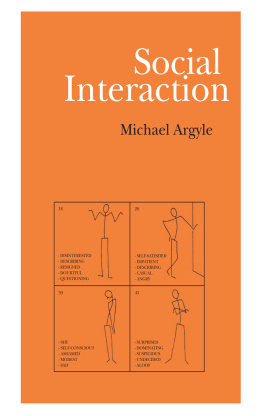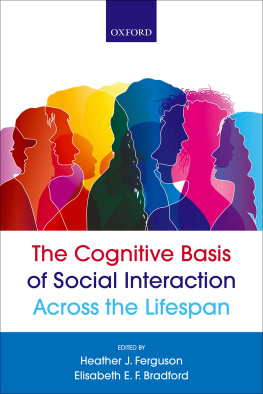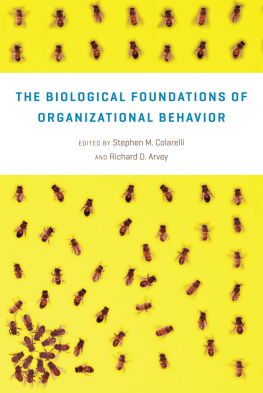Social Interaction
Social Interaction
Michael Argyle
First published 1969 by Transaction Publishers
Published 2017 by Routledge
2 Park Square, Milton Park, Abingdon, Oxon Ox14 4RN
711 Third Avenue, New York, NY 10017, USA
Routledge is an imprint of the Taylor & Francis Group, an informa business
Copyright 1969 by Michael Argyle.
All rights reserved. No part of this book may be reprinted or reproduced or utilised in any form or by any electronic, mechanical, or other means, now known or hereafter invented, including photocopying and recording, or in any information storage or retrieval system, without permission in writing from the publishers.
Notice:
Product or corporate names may be trademarks or registered trademarks, and are used only for identification and explanation without intent to infringe.
Library of Congress Catalog Number: 2006047826
Library of Congress Cataloging-in-Publication
Argyle, Michael
p. cm.
Originally published: Lobdon: Methuen, 1969.
Includes indexes.
ISBN 0-202-30912-6 (alk. paper)
1. Social interaction. I. Title.
HM1111.A74 2007
302dc22
2006047826
ISBN 13: 978-0-202-30912-5 (pbk)
For Sonia, Miranda, Nicholas, Rosalind and Ophelia
Contents
Guide
This book is intended as a textbook for students of social psychology and other social sciences. It covers some of the same ground as The Psychology of Interpersonal Behaviour but in considerably more detail.
The approach of this book differs from that of other books about social behaviour in two main ways. Firstly it analyses social behaviour in terms of the basic elements of interaction - bodily contact, proximity, orientation, gestures, facial expression, eye-movements, the verbal and non-verbal aspects of speech. Secondly it relates social interaction to its biological roots, and to the surrounding culture.
I have drawn freely from the writings of researchers in interpersonal psychiatry, primate ethology, anthropology, developmental psychology, organisational psychology, as well as those in experimental social psychology. I am particularly indebted to the pioneers of research into interaction and non-verbal communication - E. D. Chapple, J. R. Davitz, Paul Ekman, E. H. Erikson, Ralph Exline, Erving Goffman, E. T. Hall, Sidney Jourard, Albert Scheflen and T. R. Sarbin.
I am indebted to past and present members of the Oxford social psychology research group, who have collaborated on research reported here and commented on the MS - Nigel Armistead, Nicholas Bateson, Bridget Bryant, Peter Collett, Mark Cook, Janet Dean, Roger Ingham, Adam Kendon, Barbara Lalljee, Mansur Lalljee, Brian Little, Mary Lydall, Robert McHenry, Peter McPhail, Hilary Nicholson, Euan Porter, Veronica Salter, Mary Sissons, Jerry Tognoli, Ederyn Williams, and Marylin Williams,
We are grateful to Professor Albert Cherns, Hilary Clay and the Social Science Research Council for making grants to support this research, and to Douglas Seymour and Joyce Clarke who acted as consultants. Elizabeth Sidney and the staff of the Careers Research and Advisory Centre collaborated over the development of training methods. Ann McKendry and Vera Green typed the MS.
MICHAEL ARGYLE
Institute of Experimental Psychology,
Oxford
May 1968
Acknowledgements
The author and publishers would like to thank the following for permission to use figures from the sources given below:
The Editors, British Journal of Social and Clinical Psychology, for from Insight v. Desensitization in Psychotherapy by G. L. Paul.
There seems to be widespread support for the view that man's achievements in the physical sciences and technology have outstripped his powers to control them, and that it is up to the biological and social sciences to provide the necessary understanding of human nature. It may be argued that the most pressing social problems are concerned with the relationships between people, and that these are an essential and central part of human nature. Human beings are reared in families, on which they are at first completely dependent, and in which they acquire most of their learnt behaviour. The death of a close relative is a deeply disturbing experience (Gorer, 1965) and can permanently impair the personality of other members. In all communities there is work to be done, to provide food and shelter, and to satisfy other needs; this work is always performed by cooperative working groups. Outside family and work, human beings at most stages of life seek the company and support of friends. Much individual unhappiness, including that caused by mental disorder, is associated with a breakdown of relationships with other people. Most social problems consist of the breakdown of communication, interaction and cooperation between different races or classes, or between groups at work.
For many years very little was known about the process of social interaction - there were no concepts to describe it or methods to study it. During the last few years several different groups of research workers have started to look at social behaviour in a new way. They have focused their attention on the sequence of events taking place during social interaction - at the level of bodily contact and proximity, facial expression, bodily posture and gesture, head movements and direction of gaze, the verbal and non-verbal contents of speech. They looked at what happens in social encounters in more detail, and in a more concrete way than had been attempted before. We now know how these different elements function in social behaviour. The research has been carried out by workers in a number of different fields - experimental social psychology, psychotherapy research, anthropology, linguistics and animal behaviour. The advances in each of these fields are in some cases closely related, though the investigators were working quite independently. For example the research by experimental social psychologists on 'non-verbal communication' was carried out in ignorance of the work on signalling in non-human primates. Other groups have been in contact for some time. The link between work on human verbal communication and on non-verbal behaviour has hardly been made at all.
This work constitutes something of a 'new look' in the study of social behaviour. Parts of it have sometimes been referred to as 'human ethology', 'interpersonal psychiatry', 'kinesics' and 'paralinguistics'. In view of its interdisciplinary character, and since it is based on concrete interpersonal events, it is possible that it may contribute towards the integration of the biological and social sciences. Kuhn, in his account of The Structure of Scientific Revolutions (1962), points out that scientific advances are rarely produced by the refutation of earlier theories, but are brought about by groups of scientists working out alternative ways of studying or conceptualising the problems in question.
Social behaviour is often thought to be the special province of social psychology, yet some of the main advances have come from outside this field by workers in the other disciplines mentioned. It is the view of the present author that social psychology has become too isolated from other behavioural sciences, and has suffered by restricting itself too narrowly to 'social psychology' experiments and theories. A great impetus was given to social psychology by the development of experimental techniques for studying small social groups, and the early results were very interesting (cf. Cartwright and Zander, 1959; Hare, Borgatta and Bales, 1955). However, there are signs that this vein has been worked out. 'Cohesiveness' for example is a central variable here, and much of the research on small groups has been concerned with its causes and effects. Lott and Lott (1965) have produced a comprehensive review of it, from which it seems to this author that (a) little remains to be done, and (b) nothing very exciting has been found out. Mann (1967) comments:











